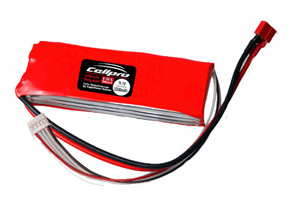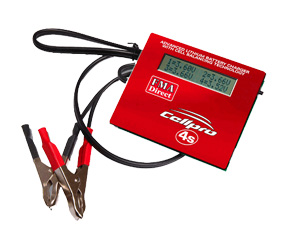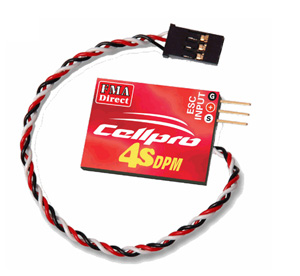

| Kokam Cell Pro Products from Aurorra Ltd. |
When you do your model flying on a tight budget, you can’t always afford top quality items. As a result, you sometimes find that expensive items get put into storage awaiting the opportunity to get the things they need to go with them.
One such case with me was a result of a couple of purchases made a while back when I got a couple of bargains on Ebay, one a Protech Unlimited electric glider and the other a lovely Balsacraft Hurricane. As funds were available at the time, I decided to buy a quality brushless motor and ESC for the Hurricane. The Unlimited I tried with a geared 600 and a direct drive 650, but neither was satisfactory. Then I crashed the Hurricane, and decided to try the Motor in the Unlimited, but due to the limited battery space (which only allows 7 cells) in the Unlimited and the motor was designed for 8-10 cells, this experiment failed. So the model was put to one side. A year passed, and the model remained on the sidelines but new battery technologies were improving and prices coming down. Then I had a real stroke of fortune, which resulted in some superb items coming my way. The items were a high quality Lithium battery and the items needed to maintain it, a combination charger/ balancer and a discharge protection module. My Unlimited was airborne again!
The items in question are a 3200mah 3s1p Kokam Cell Pro battery, a Cell pro 4s charger balancer and a Cell pro 4s Discharge Protection module. The module costs £28.20, well worth the price when a top quality battery like the Cell pro one costs £111.62 By using the Cell pro products, the battery should last a great deal longer than cheaper rivals. This cell has also proved itself at the highest level of competition.
According to the Aurorra web site,
the first FAI Competition Electric Pattern ship Flew at 2005 Nationals and came overall 5th placed out of 9 competitors in the class. It used Kokam 3200 Lithium Packs in 10s2p (37v, 6400mah) configuration successfully competed at the highest level against classic powered IC models, powered by YSDingo 140 and 160 four stroke engines.The overall weight of the plane was just less than 5Kgms, the Kokam lithium power pack was capable of delivering 120amps continuously and on pull up manoeuvres was pulling 100 amps @37 Volts (only 0.5 volt pull down per cell) that is an amazing 3.75KW power delivery.
The cell pack never exceeded 45Deg C temperature in an unventilated position in the airframe.No matter what the competition state there is no cell available other than the Kokam 3200-20c that has an internal resistance of 8milliohm and can safely deliver with no significant heat rise and voltage pull down 120 amps continuously.
The motor I originally bought for the Hurricane is a Mega Motors 22/20/4, and as this was originally intended for use with 8 cells, a Jeti 40 amp esc. The Puffin web site does not quote figures for a 3 cell lipo, but does say that for 10 cells NiMH use a 10x6 prop, which is what I fitted.
Before a maiden flight, the combination was tested on a wattmeter and showed 384Watts, at 10.2 volts and 38.2 amps. This is very close to the 40 amp ESC’s limits, but I decided to give it a try anyway. The ESC showed no signs of stress, did not get hot or cut out. Short power runs in an electric glider, which spends much of it’s time unpowered, would appear to be acceptable. But I do plan to get a more suitable ESC, however.
The first complication I encountered was that the battery was originally fitted with a Dean’s connector, since I use 4mm Gold connectors, this needed changing. The leads were also run inside the outer wrapping leaving only a couple of inches loose. Since I did not fancy soldering a 4mm plug on so close to the battery, I pulled the leads through the wrapping and changed the connectors. The battery was then charged up, using the Cell Pro charger/balancer.
 Battery
Battery
The Battery is a 3200mah 3s1p pack, and with a continuous 20c rating, this is not even stretched by the 38 amp drain of the Mega. As this combination will propel the model out of sight in about 45 seconds, motor runs tend to be fairly short. And even when there is no thermal or slope lift available, at this time of year cold hands are the limiting factor as to how long one can stay aloft.
The Battery showed 3.4v/ cell under the maximum load the motor was capable of pulling and was extremely comfortable at this level of effort, with no detectable heat gain, although this was only a fingertip test. But with the associated gear that I also use, the long term prospects are very good that this battery will last a very long time indeed. And with the added benefit that with another speed controller and motor, there is far more to come from this battery. In theory at least, this battery should be capable of producing 500 watts and more.
 Charger/Balancer
Charger/Balancer
One vitally useful function that as far as I am aware is unique to this charger is the temperature sensor. It is a little recognised fact that a cold battery has less capacity than a warm one. So charging in your nice warm house and taking the battery outside in cold weather is potentially very dangerous. This unit automatically senses the temperature, and if it is cold weather, reduces the charge to a safe level. This was activated this afternoon when I charged the battery at the site. The main screen showed Cold Charge and charging was halted a few milliamps early. Of course, this does mean a slightly reduced voltage and flight time, but this is a worthwhile sacrifice in terms of safety!
Discharge Protection Module
 The final item from Cell Pro is a Discharge Protection Module. This is a tiny unit that plugs into the receiver, the Speed controller plugs into the unit, and the battery balancer plugs into the unit. The ESC BEC is disabled, and the DPM takes over this function. By monitoring the individual cell voltages, the dpm can protect the battery if one cell is out of balance and is lower than the others. This is very useful for non-programmable speed controllers or ones that determine the cut-off point by detecting the battery voltage. And are not set as LiPo only. A partly discharged lipo can easily be detected by a speed controller as a Nicad, and the cut-off point reduced to a point below that safe for a lipo.
The final item from Cell Pro is a Discharge Protection Module. This is a tiny unit that plugs into the receiver, the Speed controller plugs into the unit, and the battery balancer plugs into the unit. The ESC BEC is disabled, and the DPM takes over this function. By monitoring the individual cell voltages, the dpm can protect the battery if one cell is out of balance and is lower than the others. This is very useful for non-programmable speed controllers or ones that determine the cut-off point by detecting the battery voltage. And are not set as LiPo only. A partly discharged lipo can easily be detected by a speed controller as a Nicad, and the cut-off point reduced to a point below that safe for a lipo.
So without one of these units it is not safe to land a model, switch off and then fly again. With the module in place, this is perfectly safe to do. In fact in an effort to test this unit I landed after some use and then flew again, but it was getting dark before the BEC cut in, with the battery still showing 3.4v/cell, well above the cutoff. But I have complete faith that this unit will perform as specified, and will again enhance the prospects of the battery lasting a long time. The one disadvantage I found with this unit was that with this particular model, in order to plug the battery into the unit and remove it again the wings had to be removed, but this was a minor inconvenience.
In fact the makers say that with the use of the charger and DPM, the battery should last 500 cycles. This is by far the best prediction I have ever heard of for a battery, and in my opinion totally justifies the initial price, which is somewhat higher than rival products.
In conclusion, the Cell Pro products are excellent value for money, the highest quality products I have seen or have heard of. I recommend them fully and intend to buy them again myself.
Terry Sullivan
Aurorra Ltd
108 Wheel Lane,
Grenoside,
Sheffield S35 8RY
Tel: 0114 2570401
e-mail info@aurorra.co.uk
| Info Panel |
|
Aurorra Products Ltd |
| Comments: Official UK Agent for FMA Direct & EP Kokam USA. |
| Online Shopping |